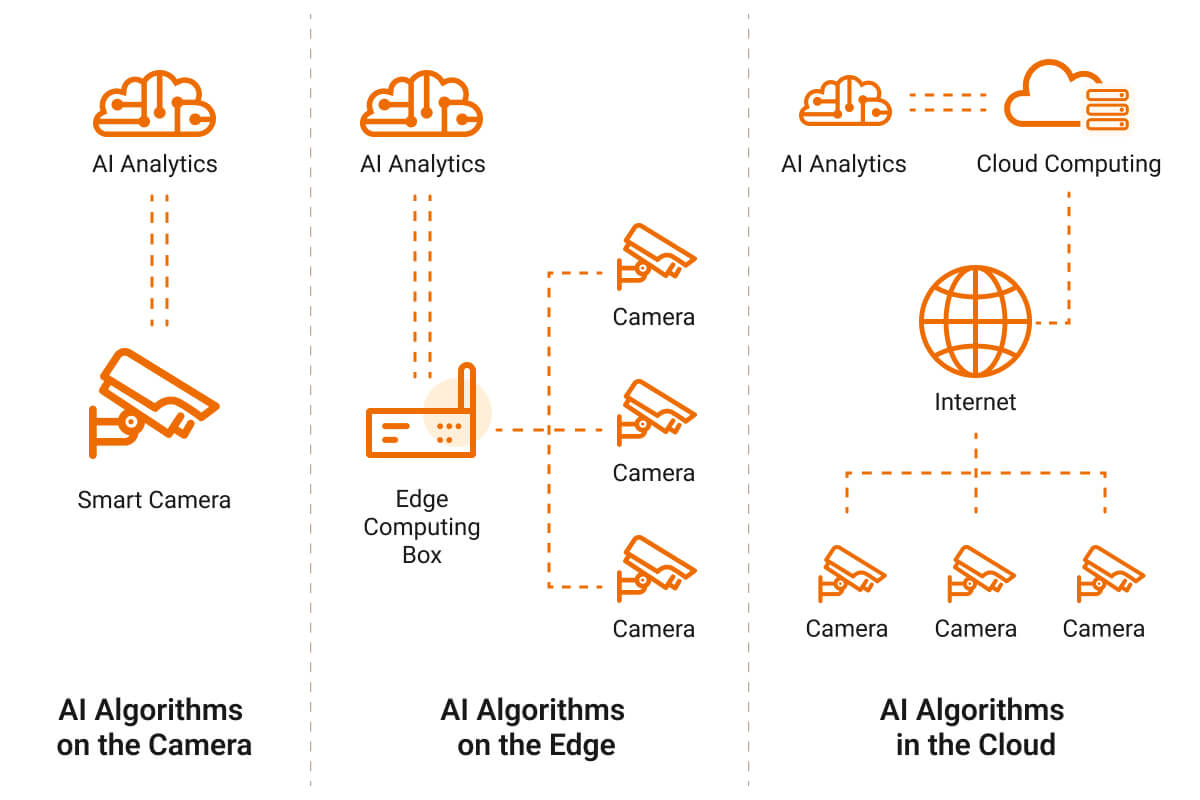I’ll compare these three SoCs to help you pick the most suitable chip for your NVR, which will make it easy to develop high-quality, tailored security surveillance recording solutions for your customers. Let’s get right into it!
What Is an NVR Network Video Recorder?
Network video recorders are specialized computers that record/encode security video surveillance footage from IP or CCTV cameras to hard drives in digital format. NVRs are typically deployed to record footage from IP cameras, which process and encode the footage, then send the data to the NVR via ethernet or WiFi for recording. But NVRs can also process and encode the data before storage. They provide a central hub for remote viewing as well.
NVRs have largely replaced DVRs (Digital Video Recorders) in security surveillance systems because they provide these benefits.
- Better image quality
- Intelligent features, such as facial, object, and license plate recognition
- Better viewing coverage
- Wired or wireless IP camera connectivity
- Easy scaling
- High compatibility with multiple IP cameras
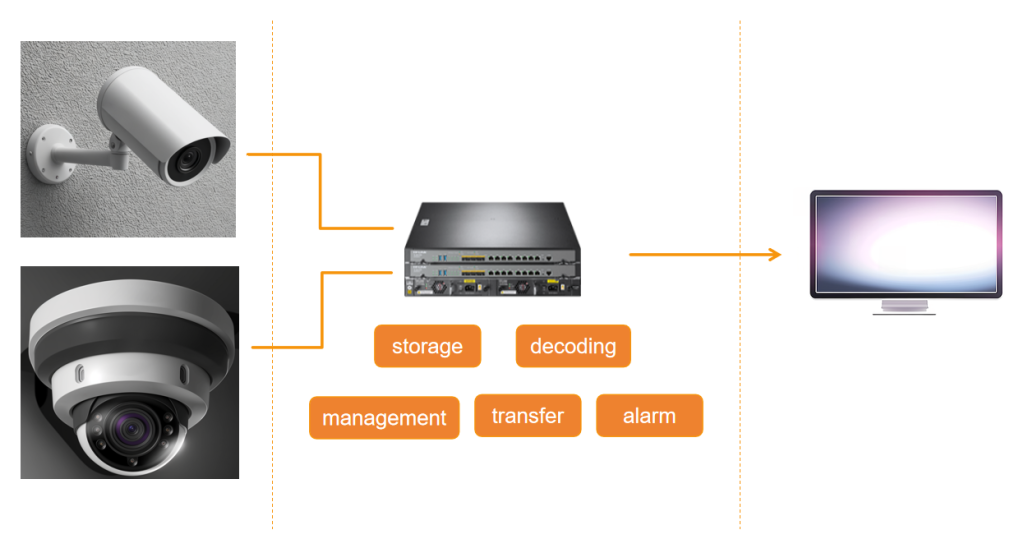
Why Use AI in NVR Network Video Recorders?
AI provides intelligence in these recorders to enable these features without needing a human to monitor the footage constantly in the background.
- Facial detection
- Fire visualization warnings
- Parking space identification for vehicles
- License plate detection
- Human detection for intrusion alarms
However, for these intelligent monitoring algorithms to work, the NVR must convert the input footage into a higher resolution. This makes it easier to identify objects in the image. Even you as a human cannot accurately spot objects in blurry footage/images.
So unlike traditional NVRs, the modern intelligent ones must have sufficient AI computing power to run the resolution enhancement and intelligent monitoring algorithms, plus the regular functions like decoding, forwarding, storage, access, etc.
Using Rockchip SoCs for Developing Security NVR Recorders
As stated earlier, the three Rockchip SoCs we’ll be focusing on feature AI cores, which makes them perfect for developing NVRs. Additionally, these chips come with the backend AI algorithms (RockIVA) implemented to handle tasks like facial detection, intelligent motion detection (for people, cars, and other objects), and perimeter detection. These help to reduce dev work, shortening the time to market.
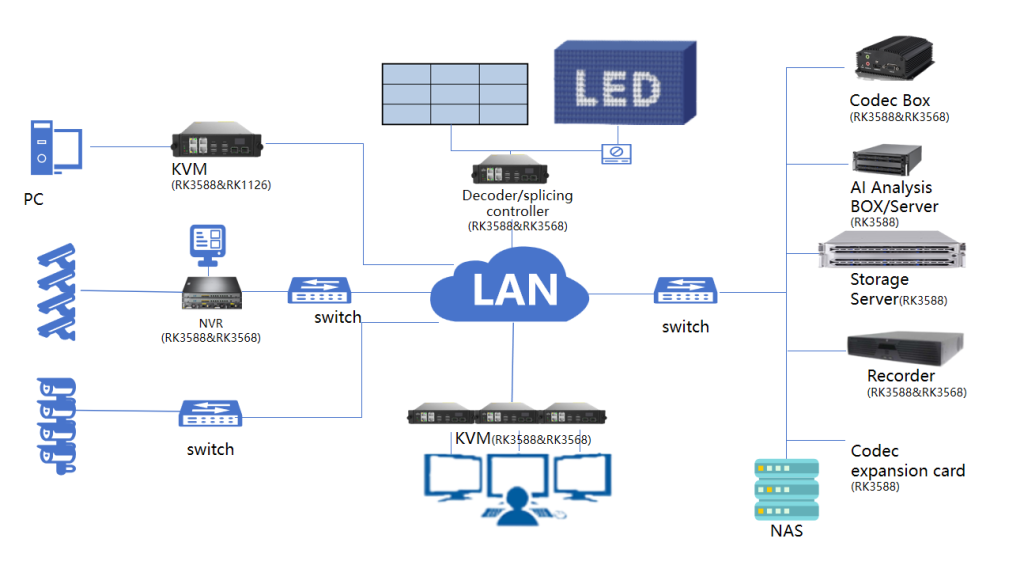
Super Resolution Technology Enabled by AI NPU – Clearer Images
The AI NPU housed in these SoCs performs image scaling or upscaling, which is essentially image stretching. Traditionally, this stretching would make the image more blurry. But the AI core and algorithms accurately guess the colors of the extra pixels to make the higher-resolution picture or footage clearer.
Here’s what you can expect from the RK3588 and RK3586. The former provides a higher output resolution because it features more powerful AI computing power (6 TOPS vs 1 TOPS).
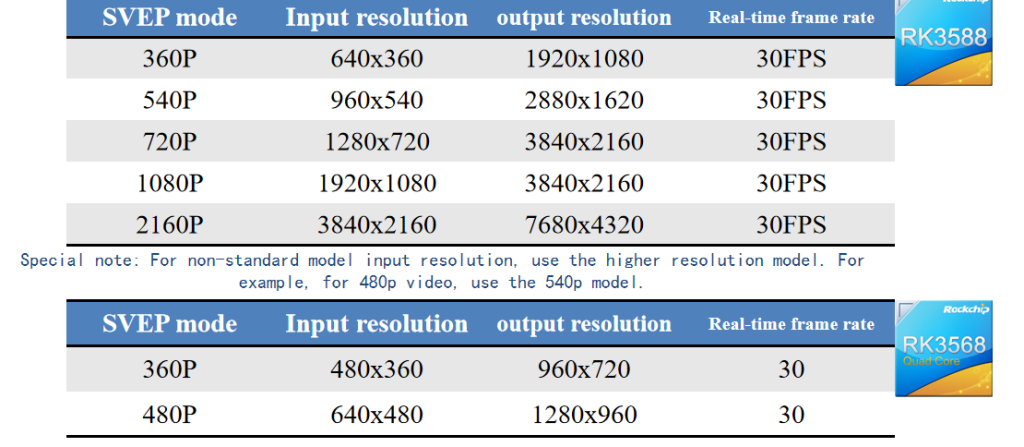
With the sharper image, the RockIVA AI algorithms can more accurately determine the objects in the image for facial recognition and intelligent motion detection.
Smart Retrieval Capability – Faster Speed
The retrieval speed of these SoCs occurs in the order of milliseconds, and this covers three aspects.
- Decoding
- Scaling
- Feature retrieval/extraction
This speed primarily depends on the input image’s resolution. For a JPG image with a 2160p resolution, the decoding time is about 312ms, while the feature extraction (text and image based on RockX) takes roughly 224ms. The scaling and comparison times are zero or negligible, so we’ll leave them out for this comparison.
Supports Multiple Cascading Modes – More Flexible
In the security network architecture, these Rockchip SoCs support multiple cascading modes to get the camera feed input for scaling, processing, and recording.
Ethernet Cascading Mode
The first mode uses an ethernet cable to either connect a Rockchip SoC to another Rockchip (RC to EP) connection or multiple x86 PC ports to a Rockchip SoC. These multiple x86 PC ports are created using a switch, which makes it possible to scale the NVR setup.
PCIe Cascading Mode
This second mode uses a PCIe cable to provide the same connections and is faster because PCIe is native in most chips (CPUs, SoCs, etc.), while ethernet needs an adapter. But both can work in these Rockchip SoCs.

Short Delay – Low Latency
Let’s consider these two scenarios. One, optimized footage or video from a PC is sent to another monitor, like from a laptop to a TV, using an HDMI switch. Two, the same footage is transmitted in this HDMIrx network through an encoder and decoder, with the connection between these two RK3588-based devices being an ethernet cable.
The first one will be instant (zero latency), while the second one will only have a latency of 16.7ms, which is negligible. But remember, Rockchip-based NVRs can optimize the footage, so if non-optimized footage is sent to the same network, the delay in scenario two is about 52ms.
If using a camera, the output on the other side will be after 33ms for optimized footage and 80–100ms for non-optimized footage. These delays won’t have a significant effect because the video shown on screen will almost be in real-time.
Besides video surveillance, this low-latency, high-res processing, and upscaling can be used in drone video transmission, medical endoscopes, LED display controls, and distributed KVMs.
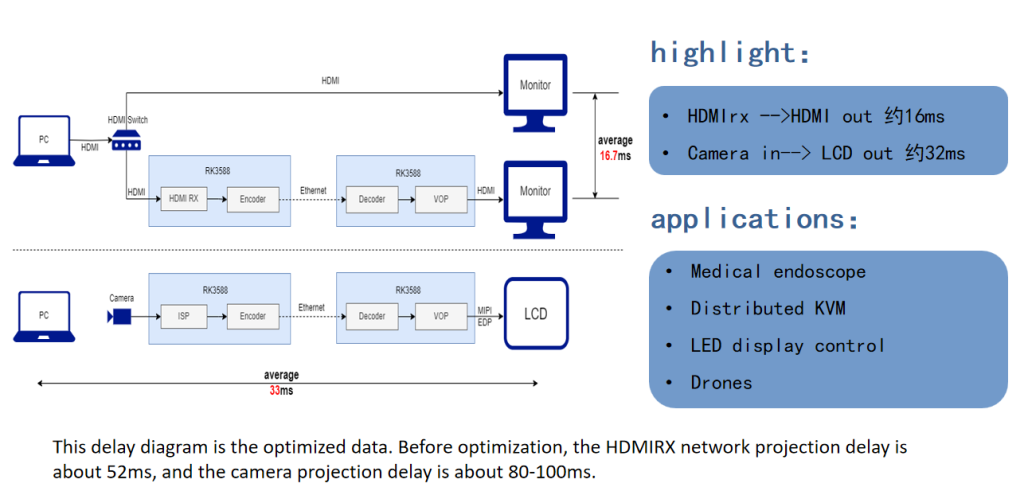
RK3568 vs RK3588 vs RK3576
Of the three, RK3588 SoCs are the most powerful, so they are suitable for developing high-end NVRs with the best upscaling features and AI video/image analysis for facial and object detection. The RK3576 falls in second place and the RK3568 last, and both can be used to develop medium or low-end solutions to rope in customers who don’t need powerful NVRs for their respective applications. Here’s a more detailed analysis of their comparison.
RK3568 vs RK3588
The RK3588 is the top-of-the-range SoC for NVR development of the three because it features a 6 TOPS NPU paired to a heterogeneous multi-core system consisting of a quad-core Cortex-A76 and a quad-core Cortex-A55. This AI computing power provides up to 8-way AI recognition capabilities to cover facial detection, intelligent motion detection, and perimeter detection.
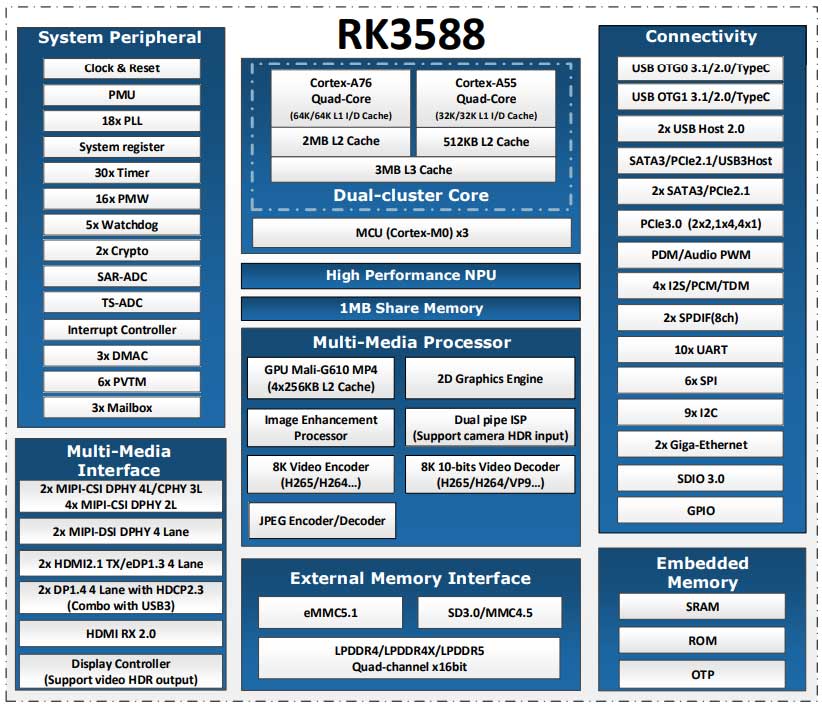
The SoC can decode up to 32 channels at 1080p (supports single-channel 3200W IPC access) with its encoding side handling half that (16 channels) at the same resolution at H.264 or H.265 compression. Other notable features include:
- ARM Mali-G610 GPU
- Supports 4 screens
- 1000Mbps access speeds with two Gigabit Ethernet ports
- 64-bit LPDDR4/LPDDR4x/LPDDR5 memory
- Multiple connectivity options (PCIe 3.0, dual RGMII, USB 3.0, SATA 3.0, etc.)
The RK3568 has a less powerful 1 TOPS NPU paired to a quad-core Cortex-A55 CPU, but this combination is still capable of developing NVRs. Its high-speed connectivity options are almost similar to the ones in the RK3588, but the SoC can only handle 10 decoding channels at 1080p (30FPS), two encoding channels still at 1080p, simultaneous outputs to two screens, and up to 320Mbps access speeds.
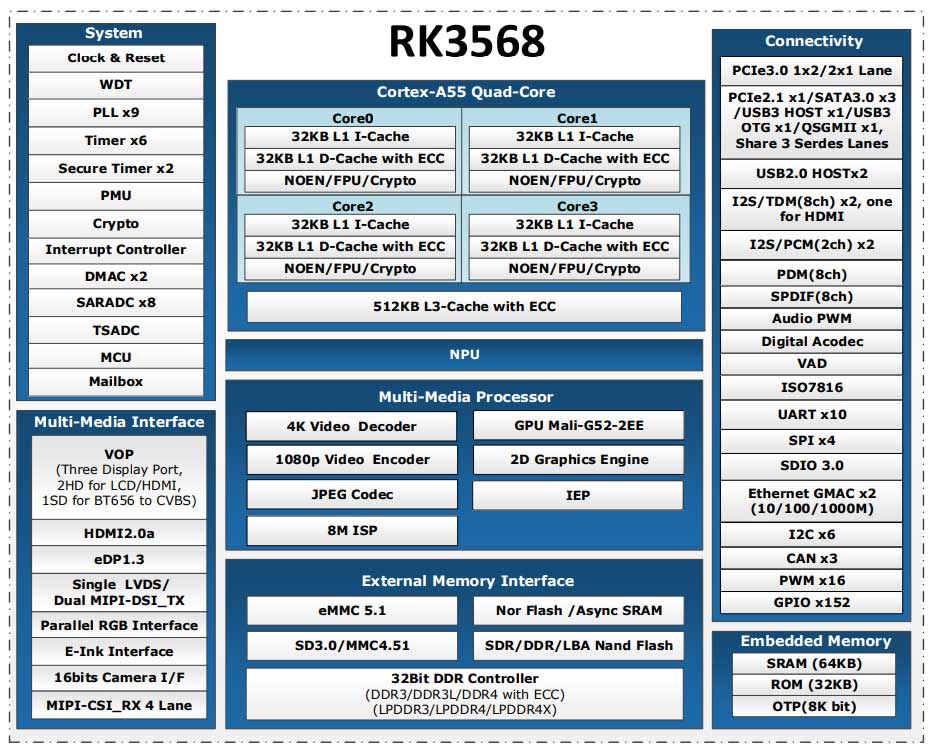
This chip’s GPU is also less powerful because it has the ARM Mali-G52 and only features 32-bit DDR3 and DDR4 memory.
RK3576 Capability for Network Video Recorders
The RK3576 falls in between the RK3568 and RK3588 performance-wise because it has a similar 6 TOPS NPU to the RK3588 but paired to a slightly less powerful heterogenous core (quad-core Cortex-A72 and Cortex-A53).
Its video encoding capabilities are also at par with the RK3588 (32 channels), but it can only send its outputs to three screens via HDMI 2.0, HDMI 1.4 (MIPI converter), and VGA (dp converter).
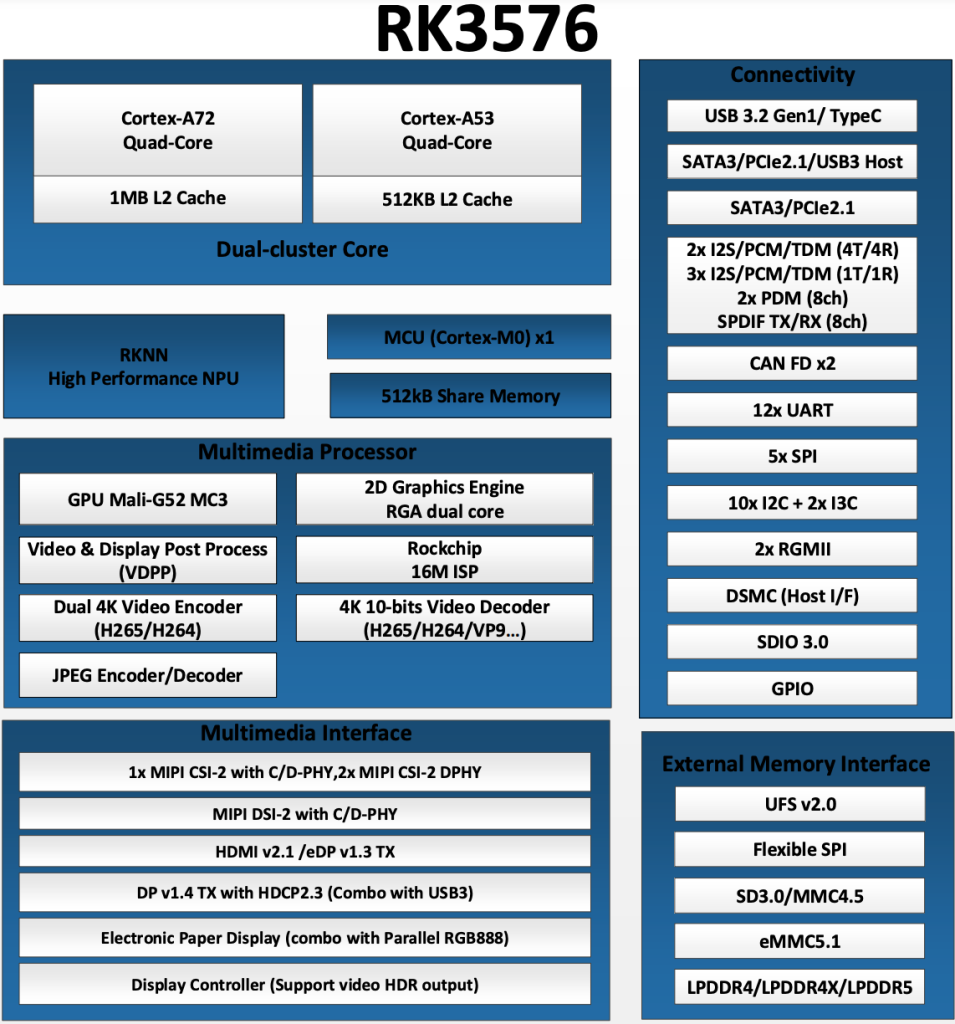
To connect to peripheral devices, such as the hard disk for recording, this chip features USB 3.0, two RGMII, and two SATA 3.0, which can be expanded to connect to up to 8 hard drives using a PM chip. On ethernet, this SoC supports up to 500Mbps access speeds.
Conclusion
While network video recorders are not new concepts, the addition of AI into the mix makes them more capable in various security installations with interconnected IP cameras. In a nutshell, AI eliminates the human aspect in video analysis to automate the detection of objects, license plates, faces, humans, motion, etc.
AI also upscales the footage to enable accurate analysis, including when retrieving the video for viewing by the relevant security personnel. Rockchip RK3568, RK3576, and RK3588 provide these benefits, but their capabilities differ according to their hardware.
So the one you pick will depend on the specific application, and the comparison above should help you in the selection process. Reach out to us with your NVR project’s specifications to help you with selection or to make an order if you’ve already settled on one platform. We have developed SoMs based on these chips that will simplify your hardware implementation.


















